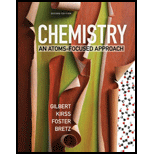
CHEM:ATOM FOC 2E CL (TEXT)
2nd Edition
ISBN: 9780393284218
Author: Stacey Lowery Bretz, Natalie Foster, Thomas R. Gilbert, Rein V. Kirss
Publisher: WW Norton & Co
expand_more
expand_more
format_list_bulleted
Question
Chapter 12, Problem 12.7VP
Interpretation Introduction
To find:
At what temperature the given process would be spontaneous.
Expert Solution & Answer
Want to see the full answer?
Check out a sample textbook solution
Students have asked these similar questions
Plan the synthesis of the following compound using the starting
material provided and any other reagents needed as long as
carbon based reagents have 3 carbons or less. Either the
retrosynthesis or the forward synthesis (mechanisms are not
required but will be graded if provided) will be accepted if all
necessary reagents and intermediates are shown (solvents and
temperature requirements are not needed unless specifically
involved in the reaction, i.e. DMSO in the Swern oxidation or
heat in the KMnO4 oxidation).
H
H
Hint These are benzene substitution reactions.
ALCI3 and UV light are catalyst no part in reactions and triangle A means
heating.
A. Add ethyl for Et in benzene ring alkylation reaction EtCl =
CH3CH2CL
1) EtC1 / AlCl3 / A
?
B: Add Br to benzene ring ( substitution)
2) Br₂ / uv light
?
C Add (CH3)2 CHCH2 in benzene ring ( substitution)
(CH3)2CHCH,C1 / AICI,
?
Draw the mechanism to make the alcohol 2-hexanol.
Draw the Mechanism to make the alcohol 1-hexanol.
Chapter 12 Solutions
CHEM:ATOM FOC 2E CL (TEXT)
Ch. 12 - Prob. 12.1VPCh. 12 - Prob. 12.2VPCh. 12 - Prob. 12.3VPCh. 12 - Prob. 12.4VPCh. 12 - Prob. 12.5VPCh. 12 - Prob. 12.6VPCh. 12 - Prob. 12.7VPCh. 12 - Prob. 12.8VPCh. 12 - Prob. 12.9VPCh. 12 - Prob. 12.10VP
Ch. 12 - Prob. 12.11QACh. 12 - Prob. 12.12QACh. 12 - Prob. 12.13QACh. 12 - Prob. 12.14QACh. 12 - Prob. 12.15QACh. 12 - Prob. 12.16QACh. 12 - Prob. 12.17QACh. 12 - Prob. 12.18QACh. 12 - Prob. 12.19QACh. 12 - Prob. 12.20QACh. 12 - Prob. 12.21QACh. 12 - Prob. 12.22QACh. 12 - Prob. 12.23QACh. 12 - Prob. 12.24QACh. 12 - Prob. 12.25QACh. 12 - Prob. 12.26QACh. 12 - Prob. 12.27QACh. 12 - Prob. 12.28QACh. 12 - Prob. 12.29QACh. 12 - Prob. 12.30QACh. 12 - Prob. 12.31QACh. 12 - Prob. 12.32QACh. 12 - Prob. 12.33QACh. 12 - Prob. 12.34QACh. 12 - Prob. 12.35QACh. 12 - Prob. 12.36QACh. 12 - Prob. 12.37QACh. 12 - Prob. 12.38QACh. 12 - Prob. 12.39QACh. 12 - Prob. 12.40QACh. 12 - Prob. 12.41QACh. 12 - Prob. 12.42QACh. 12 - Prob. 12.43QACh. 12 - Prob. 12.44QACh. 12 - Prob. 12.45QACh. 12 - Prob. 12.46QACh. 12 - Prob. 12.47QACh. 12 - Prob. 12.48QACh. 12 - Prob. 12.49QACh. 12 - Prob. 12.50QACh. 12 - Prob. 12.51QACh. 12 - Prob. 12.52QACh. 12 - Prob. 12.53QACh. 12 - Prob. 12.54QACh. 12 - Prob. 12.55QACh. 12 - Prob. 12.56QACh. 12 - Prob. 12.57QACh. 12 - Prob. 12.58QACh. 12 - Prob. 12.59QACh. 12 - Prob. 12.60QACh. 12 - Prob. 12.61QACh. 12 - Prob. 12.62QACh. 12 - Prob. 12.63QACh. 12 - Prob. 12.64QACh. 12 - Prob. 12.65QACh. 12 - Prob. 12.66QACh. 12 - Prob. 12.67QACh. 12 - Prob. 12.68QACh. 12 - Prob. 12.69QACh. 12 - Prob. 12.70QACh. 12 - Prob. 12.71QACh. 12 - Prob. 12.72QACh. 12 - Prob. 12.73QACh. 12 - Prob. 12.74QACh. 12 - Prob. 12.75QACh. 12 - Prob. 12.76QACh. 12 - Prob. 12.77QACh. 12 - Prob. 12.78QACh. 12 - Prob. 12.79QACh. 12 - Prob. 12.80QACh. 12 - Prob. 12.81QACh. 12 - Prob. 12.82QACh. 12 - Prob. 12.83QACh. 12 - Prob. 12.84QACh. 12 - Prob. 12.85QACh. 12 - Prob. 12.86QACh. 12 - Prob. 12.87QACh. 12 - Prob. 12.88QACh. 12 - Prob. 12.89QACh. 12 - Prob. 12.90QACh. 12 - Prob. 12.91QACh. 12 - Prob. 12.92QA
Knowledge Booster
Similar questions
- Draw the mechanism for the formation of diol by starting with 1-pentanal in... basic conditions then acidic conditions then draw the mechanism for the formation of a carboxylic acid from your product.arrow_forwardIdentify each chiral carbon as either R or S. Identify the overall carbohydrates as L or Darrow_forwardEthers can be formed via acid-catalyzed acetal formation. Draw the mechanism for the molecule below and ethanol.arrow_forward
- HOCH, H HO CH-OH OH H OH 11 CH₂OH F II OH H H 0 + H OHarrow_forwardDraw the mechanism for the formation of diol by starting with one pen and all in... basic conditions then acidic conditions then draw the mechanism for the formation of a carboxylic acid from your product.arrow_forwardDraw the mechanism for the oxidation of 3-bromo-cyclohexan-1-ol.arrow_forward
arrow_back_ios
SEE MORE QUESTIONS
arrow_forward_ios
Recommended textbooks for you
 ChemistryChemistryISBN:9781305957404Author:Steven S. Zumdahl, Susan A. Zumdahl, Donald J. DeCostePublisher:Cengage Learning
ChemistryChemistryISBN:9781305957404Author:Steven S. Zumdahl, Susan A. Zumdahl, Donald J. DeCostePublisher:Cengage Learning ChemistryChemistryISBN:9781259911156Author:Raymond Chang Dr., Jason Overby ProfessorPublisher:McGraw-Hill Education
ChemistryChemistryISBN:9781259911156Author:Raymond Chang Dr., Jason Overby ProfessorPublisher:McGraw-Hill Education Principles of Instrumental AnalysisChemistryISBN:9781305577213Author:Douglas A. Skoog, F. James Holler, Stanley R. CrouchPublisher:Cengage Learning
Principles of Instrumental AnalysisChemistryISBN:9781305577213Author:Douglas A. Skoog, F. James Holler, Stanley R. CrouchPublisher:Cengage Learning Organic ChemistryChemistryISBN:9780078021558Author:Janice Gorzynski Smith Dr.Publisher:McGraw-Hill Education
Organic ChemistryChemistryISBN:9780078021558Author:Janice Gorzynski Smith Dr.Publisher:McGraw-Hill Education Chemistry: Principles and ReactionsChemistryISBN:9781305079373Author:William L. Masterton, Cecile N. HurleyPublisher:Cengage Learning
Chemistry: Principles and ReactionsChemistryISBN:9781305079373Author:William L. Masterton, Cecile N. HurleyPublisher:Cengage Learning Elementary Principles of Chemical Processes, Bind...ChemistryISBN:9781118431221Author:Richard M. Felder, Ronald W. Rousseau, Lisa G. BullardPublisher:WILEY
Elementary Principles of Chemical Processes, Bind...ChemistryISBN:9781118431221Author:Richard M. Felder, Ronald W. Rousseau, Lisa G. BullardPublisher:WILEY

Chemistry
Chemistry
ISBN:9781305957404
Author:Steven S. Zumdahl, Susan A. Zumdahl, Donald J. DeCoste
Publisher:Cengage Learning

Chemistry
Chemistry
ISBN:9781259911156
Author:Raymond Chang Dr., Jason Overby Professor
Publisher:McGraw-Hill Education

Principles of Instrumental Analysis
Chemistry
ISBN:9781305577213
Author:Douglas A. Skoog, F. James Holler, Stanley R. Crouch
Publisher:Cengage Learning

Organic Chemistry
Chemistry
ISBN:9780078021558
Author:Janice Gorzynski Smith Dr.
Publisher:McGraw-Hill Education

Chemistry: Principles and Reactions
Chemistry
ISBN:9781305079373
Author:William L. Masterton, Cecile N. Hurley
Publisher:Cengage Learning

Elementary Principles of Chemical Processes, Bind...
Chemistry
ISBN:9781118431221
Author:Richard M. Felder, Ronald W. Rousseau, Lisa G. Bullard
Publisher:WILEY